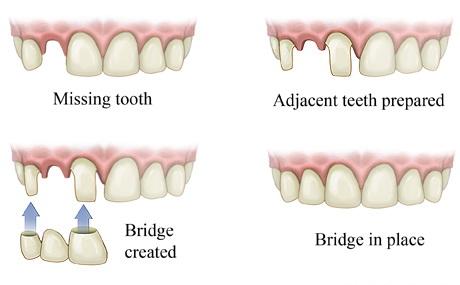What is a crown?
A crown is a cover or “cap” your dentist can put on a tooth. The crown restores the tooth to its normal shape, size and function. The purpose of a crown is to make the tooth stronger or improve the way it looks.
The difference between crown and veneer – Veneer cover only frontal surface of the tooth while crown is placed around tooth.

Benefit of crown
You may need a crown if you:
- have a cavity that is too large for a filling
- have a missing tooth and need a bridge
- need to cover a dental implant
- have a tooth that is cracked, worn down or otherwise weakened
- have had root canal treatment—the crown will protect the restored tooth
- Want to cover a discolored or badly shaped tooth and improve your smile!
What is it made from?
 |
 |
 |
| Porcelain-fused to metal | Ceramic | Base metal alloys |
Crowns are made from several types of materials. Metal alloys, ceramics, porcelain, or combinations of these materials may be used.
- Ceramic — These are used for restoring front teeth, and are popular in this area for their ability to blend with your natural tooth color.
- Porcelain-fused to metal – This crown provides a stronger bond than regular porcelain because it is connected to a metal structure. It’s also extremely durable.
- Base metal alloys – This crown is made up of non-noble metals that are highly resistant to corrosion, and make for a very strong crown. It also requires the least amount of healthy tooth to be removed prior to fitting.
Caring for your teeth
To prevent damage to a crown, there are a few things you can do:
- Brush twice a day and floss once a day to remove plaque, a sticky film of bacteria.
- Avoid chewing hard foods, ice or other hard objects, such as pencils. This is especially important for tooth-colored crowns.
- Be sure to see your dentist every 6 monthsfor regular exams and professional teeth cleanings.
What is a bridge?

A bridge, also known as a fixed removable denture, is made to replace one or more missing teeth. A bridge is made up of two or more crowns for the teeth on either side of the gap — these two or more anchoring teeth are called abutment teeth — and a false tooth/teeth in between. Bridges can be supported in any of three ways:
- By natural teeth
- By implants
- By a combination of teeth and implants
A traditional bridge is made by creating a crown for the teeth on either side of the space and placing a false tooth or teeth between the crowns. The crowns, sometimes called caps, can be supported by natural teeth or by implants. The false tooth or teeth are attached to the crowns and fill the empty space.
What Are the Benefits of Dental Bridges?
Bridges can:
- Restore your smile
- Restore the ability to properly chew and speak
- Maintain the shape of your face
- Distribute the forces in your bite properly by replacing missing teeth
- Prevent remaining teeth from drifting out of position
Disadvantage
- There is possibility of caries on dental abutment.
- The glue or cement used to fix crown might be loose.
- Regular check-up is needed.
- Abutment teeth has to be grinded.
How Do I Care for a Bridge?
It is important to keep remaining teeth healthy and strong as the success of the bridge depends on the solid foundation offered by the surrounding teeth. Brushing twice a day and flossing and using an antiseptic mouthwash daily help prevent tooth decay and gum disease that can lead to tooth loss. Keeping a regular cleaning schedule will help diagnose problems at an early stage when treatment has a better prognosis. Selecting a balanced diet for proper nutrition is also important.








